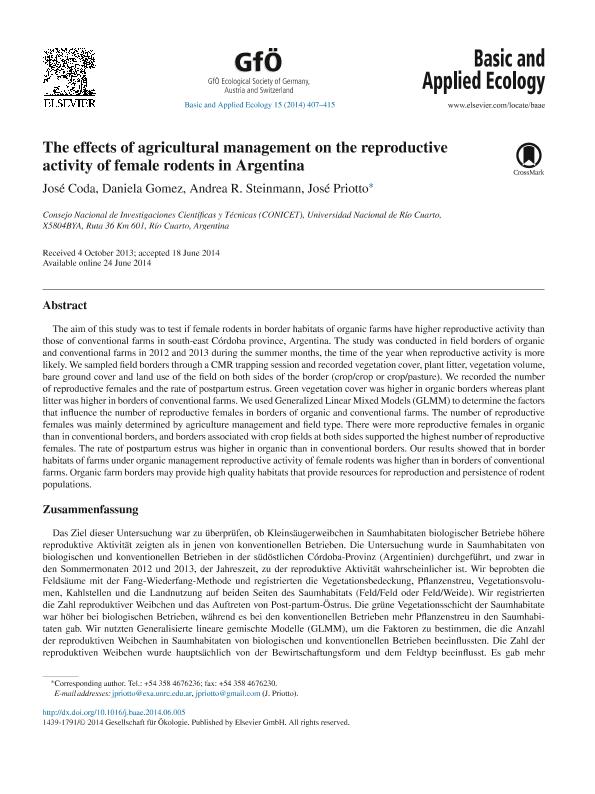Mostrar el registro sencillo del ítem
dc.contributor.author
Coda, José Antonio

dc.contributor.author
Gomez, Maria Daniela

dc.contributor.author
Steinmann, Andrea Rosa

dc.contributor.author
Priotto, Jose Waldemar

dc.date.available
2018-01-26T19:10:20Z
dc.date.issued
2014-06
dc.identifier.citation
Coda, José Antonio; Gomez, Maria Daniela; Steinmann, Andrea Rosa; Priotto, Jose Waldemar; The effects of agricultural management on the reproductive activity of female rodents in Argentina; Elsevier Gmbh; Basic and Applied Ecology; 15; 5; 6-2014; 407-415
dc.identifier.issn
1439-1791
dc.identifier.uri
http://hdl.handle.net/11336/34752
dc.description.abstract
The aim of this study was to test if female rodents in border habitats of organic farms have higher reproductive activity than those of conventional farms in south-east Córdoba province, Argentina. The study was conducted in field borders of organic and conventional farms in 2012 and 2013 during the summer months, the time of the year when reproductive activity is more likely. We sampled field borders through a CMR trapping session and recorded vegetation cover, plant litter, vegetation volume, bare ground cover and land use of the field on both sides of the border (crop/crop or crop/pasture). We recorded the number of reproductive females and the rate of postpartum estrus. Green vegetation cover was higher in organic borders whereas plant litter was higher in borders of conventional farms. We used Generalized Linear Mixed Models (GLMM) to determine the factors that influence the number of reproductive females in borders of organic and conventional farms. The number of reproductive females was mainly determined by agriculture management and field type. There were more reproductive females in organic than in conventional borders, and borders associated with crop fields at both sides supported the highest number of reproductive females. The rate of postpartum estrus was higher in organic than in conventional borders. Our results showed that in border habitats of farms under organic management reproductive activity of female rodents was higher than in borders of conventional farms. Organic farm borders may provide high quality habitats that provide resources for reproduction and persistence of rodent populations.
dc.description.abstract
Das Ziel dieser Untersuchung war zu überprüfen, ob Kleinsäugerweibchen in Saumhabitaten biologischer Betriebe höhere reproduktive Aktivität zeigten als in jenen von konventionellen Betrieben. Die Untersuchung wurde in Saumhabitaten von biologischen und konventionellen Betrieben in der südöstlichen Córdoba-Provinz (Argentinien) durchgeführt, und zwar in den Sommermonaten 2012 und 2013, der Jahreszeit, zu der reproduktive Aktivität wahrscheinlicher ist. Wir beprobten die Feldsäume mit der Fang-Wiederfang-Methode und registrierten die Vegetationsbedeckung, Pflanzenstreu, Vegetationsvolumen, Kahlstellen und die Landnutzung auf beiden Seiten des Saumhabitats (Feld/Feld oder Feld/Weide). Wir registrierten die Zahl reproduktiver Weibchen und das Auftreten von Post-partum-Östrus. Die grüne Vegetationsschicht der Saumhabitate war höher bei biologischen Betrieben, während es bei den konventionellen Betrieben mehr Pflanzenstreu in den Saumhabitaten gab. Wir nutzten Generalisierte lineare gemischte Modelle (GLMM), um die Faktoren zu bestimmen, die die Anzahl der reproduktiven Weibchen in Saumhabitaten von biologischen und konventionellen Betrieben beeinflussten. Die Zahl der reproduktiven Weibchen wurde hauptsächlich von der Bewirtschaftungsform und dem Feldtyp beeinflusst. Es gab mehr reproduktive Weibchen auf biologischen als auf konventionellen Betrieben, und Saumhabitate mit Feldern auf beiden Seiten beherbergten die meisten reproduktiven Weibchen. Post-partum-Östrus trat in biologischen Saumhabitate häufiger auf als in konventionellen Saumhabitaten. Unsere Ergebnisse zeigten, dass die reproduktive Aktivität der Kleinsäugerweibchen in Saumhabitaten von biologischen Betrieben höher war als in denen von konventionellen Betrieben. Die Saumhabitate von biologischen Betrieben sind vermutlich qualitativ hochwertige Lebensräume, die den Kleinsäugerpopulationen Ressourcen für die Reproduktion und das Überleben bieten.
dc.format
application/pdf
dc.language.iso
eng
dc.publisher
Elsevier Gmbh

dc.rights
info:eu-repo/semantics/openAccess
dc.rights.uri
https://creativecommons.org/licenses/by-nc-nd/2.5/ar/
dc.subject
Organic Vs. Conventional Farms
dc.subject
Border Habitat
dc.subject
Habitat Quality
dc.subject
Rodent Populations
dc.subject
Reproductive Activity
dc.subject
Postpartum Estrus
dc.subject
Vegetation Volume
dc.subject
Glmm
dc.subject.classification
Otras Ciencias Biológicas

dc.subject.classification
Ciencias Biológicas

dc.subject.classification
CIENCIAS NATURALES Y EXACTAS

dc.title
The effects of agricultural management on the reproductive activity of female rodents in Argentina
dc.type
info:eu-repo/semantics/article
dc.type
info:ar-repo/semantics/artículo
dc.type
info:eu-repo/semantics/publishedVersion
dc.date.updated
2018-01-25T20:49:23Z
dc.journal.volume
15
dc.journal.number
5
dc.journal.pagination
407-415
dc.journal.pais
Alemania

dc.description.fil
Fil: Coda, José Antonio. Universidad Nacional de Río Cuarto. Facultad de Ciencias Exactas, Fisicoquímicas y Naturales. Departamento de Ciencias Naturales; Argentina. Consejo Nacional de Investigaciones Científicas y Técnicas; Argentina
dc.description.fil
Fil: Gomez, Maria Daniela. Universidad Nacional de Río Cuarto. Facultad de Ciencias Exactas, Fisicoquímicas y Naturales. Departamento de Ciencias Naturales; Argentina. Consejo Nacional de Investigaciones Científicas y Técnicas; Argentina
dc.description.fil
Fil: Steinmann, Andrea Rosa. Universidad Nacional de Río Cuarto. Facultad de Ciencias Exactas, Fisicoquímicas y Naturales. Departamento de Ciencias Naturales; Argentina. Consejo Nacional de Investigaciones Científicas y Técnicas; Argentina
dc.description.fil
Fil: Priotto, Jose Waldemar. Universidad Nacional de Río Cuarto. Facultad de Ciencias Exactas, Fisicoquímicas y Naturales. Departamento de Ciencias Naturales; Argentina. Consejo Nacional de Investigaciones Científicas y Técnicas; Argentina
dc.journal.title
Basic and Applied Ecology

dc.relation.alternativeid
info:eu-repo/semantics/altIdentifier/doi/http://dx.doi.org/10.1016/j.baae.2014.06.005
dc.relation.alternativeid
info:eu-repo/semantics/altIdentifier/url/https://www.sciencedirect.com/science/article/pii/S1439179114000668
Archivos asociados
